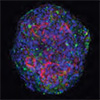| Nov 16, 2023 |
|
|
|
(Nanowerk News) For decades, scientists have faced substantial challenges in developing robust experimental models that accurately mimic human liver biology. Traditional cell lines and animal models often fail to replicate key aspects of human hepatic structure and function. This limitation has hampered progress in unraveling the molecular underpinnings of liver diseases and evaluating new drug and treatment strategies.
|
|
Now, researchers from the University of Tokyo have engineered significant enhancements to liver organoid technology that bring its performance and reliability more in line with actual human liver tissue. Their refinements, described in a paper published in Biotechnology Journal (“Establishment of a cell culture platform for human liver organoids and its application for lipid metabolism research”), deliver major upgrades to liver organoid growth, characterization, and modification that pave the way for diverse applications from basic research to regenerative medicine.
|
|
The liver performs over 500 vital functions, including glucose regulation, detoxification, and production of bile, cholesterol, and blood proteins. Chronic inflammation and damage to liver tissue underlie many globally prevalent conditions like hepatitis, cirrhosis, and liver cancer. Developing effective preventions and treatments demands model systems that reproduce fine aspects of human liver physiology. But commonly used HepG2 and HepaRG human cell lines as well as animal models deviate substantially from human liver behavior. Though primary human liver cells retain functionality ex vivo, their limited availability and short lifespan constrain routine use.
|
|
This is where liver organoids come in. Organoids are miniature 3D tissue cultures that self-organize from stem cells into small versions of organs. Their physiology closely matches that of the source tissue. Intestinal organoids cured mice of colon inflammation by regenerating colon tissue when transplanted. The possibility of growing liver organoids from human induced pluripotent stem cells suggested similar potential for modeling and treating liver diseases. But realizing this promise has required overcoming barriers to organoid growth, analysis, and manipulation.
|
|
The University of Tokyo team’s advances on three fronts now make liver organoids a practical platform for studying human liver biology. First, they engineered mouse L cells to continuously secrete a customized blend of four essential growth factors—R-spondin 1, hepatocyte growth factor (HGF), and fibroblast growth factors 7 and 10. The conditioned medium from these cells could expand both pluripotent stem cell-derived and primary tissue-derived human liver organoids over multiple passages. This removed the need to supplement cultures with expensive recombinant proteins.
|
|
Next, the researchers determined that switching between two distinct media could control organoid growth versus maturation. Expansion medium containing the L cell factors propagated organoids by stimulating proliferation of liver stem cells. In contrast, switching to a differentiation medium halted growth and enhanced production of mature hepatic proteins like albumin. This ability to toggle between proliferative and functional states enabled detailed characterization of organoids’ liver-like traits.
|
|
Crucially, organoids displayed several physiological features absent from traditional models. They activated insulin signaling and lipid synthesis in response to insulin. They expressed functional nuclear receptors that govern metabolism. When fed surplus fatty acids, they accumulated cytoplasmic lipid droplets just as actual hepatocytes do. Most remarkably, they secreted very-low-density lipoproteins (VLDL) that were identical in density to those produced in human livers. This contrasts starkly with mouse models that cannot secrete proper VLDL and with HepG2 cells that mainly release denser lipoprotein particles. Proper VLDL secretion is vital because its dysregulation causes atherosclerosis. Liver organoids finally offer a platform for unraveling the mechanics of this key human-specific process.
|
|
Finally, the team realized that briefly reverting organoids to a 2D monolayer enabled highly efficient lentiviral transduction of exogenous genes. Returning transduced cells to 3D culture yielded organoids stably expressing introduced constructs. As proof-of-concept, they used this approach to overexpress perilipin 2, which enhanced lipid accumulation as expected. This methodology now opens the door to diverse gene editing and functional characterization studies.
|
|
Together, these advances provide researchers across many disciplines with improved tools to unlock secrets of human liver biology using organoid models. They also bring closer the possibility of personalized disease modeling by deriving organoids from patient-matched induced pluripotent stem cells. With additional work to optimize organoid maturation, researchers see strong potential for applications from drug toxicity screening to even bioartificial livers. By making organoids more physiologically complete and experimentally tractable, this study helps position them as a mainstay of liver research for years to come.
|

